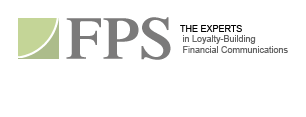 |
 |
| JUNE 2010 |  |
What we do |  |
Work Samples |  |
FPS Resource Library |
|
Trick or 'Tweet': Banks Using Twitter See Risks – But Better Rewards by Brian O'Connell Can bank marketers get their message across to customers — both retail and corporate — in 140 words or less? Better yet, should they have to? The likely answer is "yes," as more banks turn to social networking giant Twitter to reach out to customers. In doing so, bank marketers are opening two doors at once:
Targeting Generation Y While banks are using Twitter for myriad reasons — to communicate with business partners, to let the media know about a new event or announcement, and to draw audiences in real time to trade shows and conferences — it's the consumer base that's seeing the most action. Of particular importance to the Door #1 argument is the ability to reach out to one of the banking industry's most appealing demographic: Generation Y (those born between 1980 and 1990). According to a recent report by Deloitte, "Catalysts for Change — the Implications of Gen Y Consumers for Banks." Generation Y is just entering its first big "pay day" years and is the genuine heir to the Baby Boomers, at least in terms of consumer spending. The Deloitte report says that Gen Y overall consumer spending will increase from $600 billion in 2009 to $2.45 trillion by 2015. In addition, by 2017, Gen Y will outnumber both Generation X and the Boomers. Gen Y is also the first American generation to use social networking tools like Twitter to reach out to banks. Mostly, they do so to register consumer complaints. But once the dialogue is established, banks can interact with such customers, find out their needs and concerns, and tailor a banking experience that accommodates those needs. Maybe that's why, compared globally, U.S. banks are becoming the largest users of Twitter. For example, the Deloitte report notes, U.S. banks have a 72% Twitter "visibility" rating, compared to German banks, which rank second with a 6% Twitter rating. Gen Y members love engaging each other in social media, and U.S. banks so crave the ability to interact with this techno-savvy generation that they are willing to take on the collateral risk associated with Twitter. One risk is communicating over a non-secure network. Another risk is being scorched with adverse publicity growing out of posts by dissatisfied customers. Current Twitter bank campaigns U.S. banks are still novices in Twitter involvement, primarily using it for community building, customer service and product research. Nevertheless, bank marketers are expected to be a big user of the Twitter platform for bank marketing campaigns. How are banks currently marketing their services via Twitter? Here are some examples:
Target customer service first — and keep it safe If your bank is considering using Twitter to reach out to customers, start with a focused strategy of targeting customer service, live feedback and idea generation. Customer service, in particular, is a huge "pull" for bank marketers looking to establish real relationships with customers. It's an easy and relatively painless path from sharing financial tips and answering account questions to talking about the annual percent yield (APY) on your latest certificate of deposit offering. Also, you need to practice caution and move conversations from Twitter to offline once the talk turns to the customer's personal or business needs. Banks that fare best with Twitter are those that use the social media network to engage customers while at the same time emphasizing the importance of doing bank business via the bank's secure online interface. Take a cue from Wells Fargo Bank, which in a recent Tweet cautioned customers, "While we want to be where you are on Twitter, we will never ask you for account info here. Please keep your hard earned money safe." In the end, bank marketers who ignore Twitter do so at their own risk. Just like the head of the U.S Postal Service, who back in 1923 mistakenly dismissed the telephone as only a means of talking to one's servants, banks can't afford to keep social networking tools like Twitter on the back burner. With 19 million U.S. Twitter users — and Twitter expects that number to rise to 26 million by the end of 2010 — there's simply too much at stake to neglect this important social media channel. Brian O'Connell is a former Wall Street bond trader and current author and writer with two "Book of the Month Club" investment titles, as well as bylines in major media platforms like The Wall Street Journal, TheStreet.com, CBS MarketWatch, Entrepreneur, Yahoo Finance and many others. He writes regularly about banking issues for BankingMyWay.com. . . . If you are not already a MarketScope subscriber, please request your own free monthly edition. |